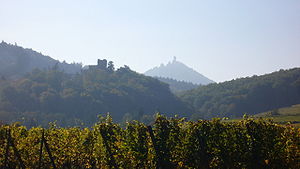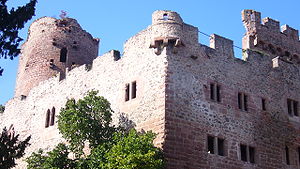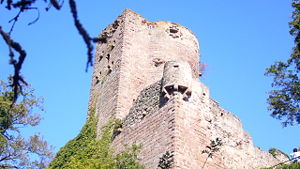
Château de Kintzheim
Encyclopedia
Château de Kintzheim is a castle
in Kintzheim
, Bas-Rhin
, France
dating from the 12th century. The ruins of the château dominate the village of Kintzheim.

The Merovingian kings had made it into the center of a vast domain including the valley of the Liepvre
River and the forests of Haut-Koenigsbourg.

 The construction of the château began around 1250 on the order of Emperor Frederick II of Hohenstaufen
The construction of the château began around 1250 on the order of Emperor Frederick II of Hohenstaufen
. The keep
and the rampart which belongs to it were finished at the end of the 13th century. The residential structures were built during the 14th and the 15th centuries. In 1341, Emperor Louis IV
, known as "The Bavarian", gave the village of Kinsen to the town of Sélestat
.
In 1492, on the order of Emperor Frederick III of Habsburg
, the landvogt of Alsace, Gaspard de Morimont, sold the château to the town of Sélestat
.
, his heir, the chateau was abandoned following the French Revolution
of 1789. The roofs disappeared around 1830.
In 1801 the marquis de Broc put the chateau up for sale. The town of Sélestat tried to regain possession of the property.
In 1807 a decree of Emperor Napoleon I
gave the chateau to Mathieu de Favier, who was obliged to pay 2000 silver marks to the town of Sélestat to settle their claim.
style. Between the two structures he built a park in the English style, which today is classified by the Ministry of Culture of France as one of the Notable Gardens of France
. He created a romantic landscape garden, or jardin tableau, to highlight the view of the ruined castle, inspired by the paintings of Nicolas Poussin
, Claude Lorraine, and Hubert Robert
.
The family of Mathieu de Fabvier was close to the family of a Minister of Finance of France, Jean-Georges Humann (1780-1842), whose descendants later became responsible for preserving the chateau.
During the 19th century, the romantic movement brought medieval castles back into style. many castles in France were restored by Viollet-le-Duc while in Germany Bodo Ebhardt restored many castles, including the castle of Haut-Koenigsbourg, inaugurated by the Emperor William II of Germany in 1908. In 1876, German architects carried out a consolidation of the ruins of Kintzheim.
, falcon
s, and vultures, which are in danger of extinction. Spectators can attend daily flights of the birds.
Castle
A castle is a type of fortified structure built in Europe and the Middle East during the Middle Ages by European nobility. Scholars debate the scope of the word castle, but usually consider it to be the private fortified residence of a lord or noble...
in Kintzheim
Kintzheim
Kintzheim is a commune in the Bas-Rhin department in Alsace in north-eastern France.The Château de Kintzheim is a well-known landmark in the commune.-Heraldry:The Kintzheim coat of arms is a black eagle on a white background...
, Bas-Rhin
Bas-Rhin
Bas-Rhin is a department of France. The name means "Lower Rhine". It is the more populous and densely populated of the two departments of the Alsace region, with 1,079,013 inhabitants in 2006.- History :...
, France
France
The French Republic , The French Republic , The French Republic , (commonly known as France , is a unitary semi-presidential republic in Western Europe with several overseas territories and islands located on other continents and in the Indian, Pacific, and Atlantic oceans. Metropolitan France...
dating from the 12th century. The ruins of the château dominate the village of Kintzheim.

History
Kintzheim was known in the 6th century under the name of Regis Villa.The Merovingian kings had made it into the center of a vast domain including the valley of the Liepvre
Lièpvre
Lièpvre is a commune in the Haut-Rhin department in Alsace in north-eastern France.In the 8th century saint and abbot, Fulrad, built a monastery and filled it with relics of Saint Cucuphas.-Geography:...
River and the forests of Haut-Koenigsbourg.
- In 774 the emperor CharlemagneCharlemagneCharlemagne was King of the Franks from 768 and Emperor of the Romans from 800 to his death in 814. He expanded the Frankish kingdom into an empire that incorporated much of Western and Central Europe. During his reign, he conquered Italy and was crowned by Pope Leo III on 25 December 800...
made a gift to the Abbey of Liepvre of one part of his forests at Gunigesheim. - In 775 Charlemagne spent the ChristmasChristmasChristmas or Christmas Day is an annual holiday generally celebrated on December 25 by billions of people around the world. It is a Christian feast that commemorates the birth of Jesus Christ, liturgically closing the Advent season and initiating the season of Christmastide, which lasts twelve days...
holidays in the Palatium selestatis, probably located at Kintzheim. - In 843 the Emperor Lothair ILothair ILothair I or Lothar I was the Emperor of the Romans , co-ruling with his father until 840, and the King of Bavaria , Italy and Middle Francia...
, the grandson of Charlemagne, gave Kintzheim to Erchangar, the Count of Nordgau and father of Richarde, the future abbesse of AndlauAndlauAndlau is a commune in the Bas-Rhin department in Alsace in north-eastern France.The village owes its origin to Andlau Abbey which was founded in AD 880 by Richardis, the Empress of Charles the Fat...
.
From the 12th to the 16th centuries


Frederick II, Holy Roman Emperor
Frederick II , was one of the most powerful Holy Roman Emperors of the Middle Ages and head of the House of Hohenstaufen. His political and cultural ambitions, based in Sicily and stretching through Italy to Germany, and even to Jerusalem, were enormous...
. The keep
Keep
A keep is a type of fortified tower built within castles during the Middle Ages by European nobility. Scholars have debated the scope of the word keep, but usually consider it to refer to large towers in castles that were fortified residences, used as a refuge of last resort should the rest of the...
and the rampart which belongs to it were finished at the end of the 13th century. The residential structures were built during the 14th and the 15th centuries. In 1341, Emperor Louis IV
Louis IV, Holy Roman Emperor
Louis IV , called the Bavarian, of the house of Wittelsbach, was the King of Germany from 1314, the King of Italy from 1327 and the Holy Roman Emperor from 1328....
, known as "The Bavarian", gave the village of Kinsen to the town of Sélestat
Sélestat
Sélestat is a commune in the Bas-Rhin department in Alsace in north-eastern France.In 2006, Sélestat had a total population of 19,459. The Communauté de communes de Sélestat et environs had a total population of 35,397.-Geography:...
.
In 1492, on the order of Emperor Frederick III of Habsburg
Frederick III, Holy Roman Emperor
Frederick the Peaceful KG was Duke of Austria as Frederick V from 1424, the successor of Albert II as German King as Frederick IV from 1440, and Holy Roman Emperor as Frederick III from 1452...
, the landvogt of Alsace, Gaspard de Morimont, sold the château to the town of Sélestat
Sélestat
Sélestat is a commune in the Bas-Rhin department in Alsace in north-eastern France.In 2006, Sélestat had a total population of 19,459. The Communauté de communes de Sélestat et environs had a total population of 35,397.-Geography:...
.
In the 17th and 18th centuries
- In 1633 the chateau was partly destroyed by the SwedesSwedenSweden , officially the Kingdom of Sweden , is a Nordic country on the Scandinavian Peninsula in Northern Europe. Sweden borders with Norway and Finland and is connected to Denmark by a bridge-tunnel across the Öresund....
during the Thirty Years' WarThirty Years' WarThe Thirty Years' War was fought primarily in what is now Germany, and at various points involved most countries in Europe. It was one of the most destructive conflicts in European history....
. - In 1649 the town of Sélestat sold the chateau for 3 000 florins to J. G. de Gollen, former mayor of the town, who had been the minister of Ferdinand III of HabsburgFerdinand III, Holy Roman EmperorFerdinand III was Holy Roman Emperor from 15 February 1637 until his death, as well as King of Hungary and Croatia, King of Bohemia and Archduke of Austria.-Life:...
to the Peace of WestphaliaPeace of WestphaliaThe Peace of Westphalia was a series of peace treaties signed between May and October of 1648 in Osnabrück and Münster. These treaties ended the Thirty Years' War in the Holy Roman Empire, and the Eighty Years' War between Spain and the Dutch Republic, with Spain formally recognizing the...
, which ended the Thirty Years' War. - Between 1650 and 1670 J. G. de Gollen restored the residential buildings and the chapel, but never actually lived in the chateau.
- Between 1760 and 1780 the last resident of the chateau was a hermit monk who took care of the chapel.
18th and 19th centuries
Taken care of during the 18th century by J. G. de Gollen, then by the marquis de BrocBroc
Broc is a municipality in the district of Gruyère in the canton of Fribourg in Switzerland.-History:Broc is first mentioned in 1115 as Broc and Broch. The municipality was formerly known by its German name Bruck, however, that name is no longer used.-Geography:Broc has an area, , of...
, his heir, the chateau was abandoned following the French Revolution
French Revolution
The French Revolution , sometimes distinguished as the 'Great French Revolution' , was a period of radical social and political upheaval in France and Europe. The absolute monarchy that had ruled France for centuries collapsed in three years...
of 1789. The roofs disappeared around 1830.
In 1801 the marquis de Broc put the chateau up for sale. The town of Sélestat tried to regain possession of the property.
In 1807 a decree of Emperor Napoleon I
Napoleon I
Napoleon Bonaparte was a French military and political leader during the latter stages of the French Revolution.As Napoleon I, he was Emperor of the French from 1804 to 1815...
gave the chateau to Mathieu de Favier, who was obliged to pay 2000 silver marks to the town of Sélestat to settle their claim.
19th and 20th centuries
In 1802 the future Baron of the Second Empire Gaetan Mathieu de Favier bought the chateau, and below it he built a manor house in the DirectoryFrench Directory
The Directory was a body of five Directors that held executive power in France following the Convention and preceding the Consulate...
style. Between the two structures he built a park in the English style, which today is classified by the Ministry of Culture of France as one of the Notable Gardens of France
Notable gardens of France
The Remarkable Gardens of France is intended to be a list and description, by region, of the over two hundred gardens classified as "Jardins remarquables" by the French Ministry of Culture and the Comité des Parcs et Jardins de France...
. He created a romantic landscape garden, or jardin tableau, to highlight the view of the ruined castle, inspired by the paintings of Nicolas Poussin
Nicolas Poussin
Nicolas Poussin was a French painter in the classical style. His work predominantly features clarity, logic, and order, and favors line over color. His work serves as an alternative to the dominant Baroque style of the 17th century...
, Claude Lorraine, and Hubert Robert
Hubert Robert
Hubert Robert , French artist, was born in Paris.His father, Nicolas Robert, was in the service of François-Joseph de Choiseul, marquis de Stainville a leading diplomat from Lorraine...
.
The family of Mathieu de Fabvier was close to the family of a Minister of Finance of France, Jean-Georges Humann (1780-1842), whose descendants later became responsible for preserving the chateau.
During the 19th century, the romantic movement brought medieval castles back into style. many castles in France were restored by Viollet-le-Duc while in Germany Bodo Ebhardt restored many castles, including the castle of Haut-Koenigsbourg, inaugurated by the Emperor William II of Germany in 1908. In 1876, German architects carried out a consolidation of the ruins of Kintzheim.
- In 1945, during the World War IIWorld War IIWorld War II, or the Second World War , was a global conflict lasting from 1939 to 1945, involving most of the world's nations—including all of the great powers—eventually forming two opposing military alliances: the Allies and the Axis...
battle for Alsace, the chateau was used as an observation post, and the tower was hit by artillery shells. - In 1965, the ruins of the chateau were classified as a monument historiqueMonument historiqueA monument historique is a National Heritage Site of France. It also refers to a state procedure in France by which national heritage protection is extended to a building or a specific part of a building, a collection of buildings, or gardens, bridges, and other structures, because of their...
by the French Ministry of CultureMinister of Culture (France)The Minister of Culture is, in the Government of France, the cabinet member in charge of national museums and monuments; promoting and protecting the arts in France and abroad; and managing the national archives and regional "maisons de culture"...
. - In 1968 "The Eagle's Nest" was installed at the ruins, and became a tourist attraction drawing about 150,000 visitors each year.
The Château de Kintzheim Today
Since 1968 the castle features "La volerie des aigles" (Eng: The Eagles' Nest), which presents species of predatory birds, such as eaglesEagle
Eagles are members of the bird family Accipitridae, and belong to several genera which are not necessarily closely related to each other. Most of the more than 60 species occur in Eurasia and Africa. Outside this area, just two species can be found in the United States and Canada, nine more in...
, falcon
Falcon
A falcon is any species of raptor in the genus Falco. The genus contains 37 species, widely distributed throughout Europe, Asia, and North America....
s, and vultures, which are in danger of extinction. Spectators can attend daily flights of the birds.

